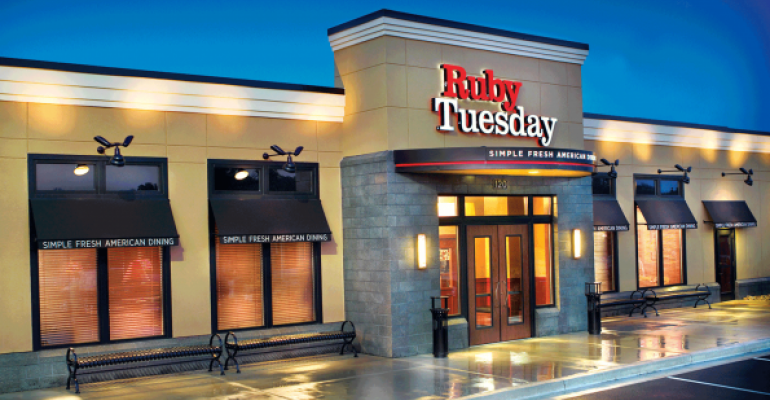“It’s too early to tell.”
Those words were spoken numerous times during the last two Ruby Tuesday Inc. investor conference calls, before the September resignation of the CEO, in reference to actions taken to reverse declining sales.
To put those words in perspective, former Ruby Tuesday CEO J.J. Buettgen had been on the job for more than three years. What was happening during those prior three years? Was the board putting pressure on management? Presumably so, but how much?
No one knows the answers to those questions except Buettgen and the board. What we do know is that the company has underperformed its peer group for the better part of a decade, and underperformed consistently for the last four years.
In the summer of 2011, activist investors got involved with Ruby Tuesday and gained two board seats. Within a year and a half, essentially all senior management had turned over, including the hiring of the new CEO. Less than a year after Buettgen was hired, in November 2012, activist investors had sold their stock and resigned from the board. Buettgen’s resignation completed a second round of senior management changes since mid-2011.
During this tumultuous time, the board was the most stable aspect of the company: three of the seven current directors (eight before the resignation of Buettgen) were on the board in 2010.
From the outside, it appears as if the board was too passive in holding management accountable for Ruby Tuesday’s performance. Admittedly, there is a fine line between giving a new team time to implement its strategy and making a change.
To his credit, Buettgen decided on a strategy and stuck with it throughout his tenure. It was a logical strategy, with heavy emphasis on returning Ruby Tuesday to its roots and improving marketing.

But it didn’t work. In the casual-dining segment, bold change was, and is, needed, and the board, in my opinion, was too complacent and did not push for those kinds of changes soon enough, if they have yet.
Among the actions being taken are a revitalized Garden Bar, a restaurant remodeling test, and closing nearly 100 locations. The Garden Bar is Ruby Tuesday’s key point of differentiation from other casual-dining restaurants. A knowledgeable person told me that the new Garden Bar was truly significant and could potentially position the brand to better compete against some of the fast-casual salad concepts — a bold step, in his opinion.
With that description, I visited a test restaurant about a year ago expecting a lot, only to be sorely disappointed. Ruby Tuesday’s market research may contradict my impression, but I found it hard to believe that the Garden Bar I experienced would drive sustainable traffic increases.
I have yet to visit a remodeled restaurant, but the publicly disclosed information is hardly exciting. Management has indicated that the remodel under consideration costs in the neighborhood of $350,000 and, in test, has generated a mid-single-digit sales increase.
Assuming a $120,000 sales bump and a 45-percent incremental margin, the return on the $350,000 investment is approximately 15 percent. While that exceeds the cost of the company’s debt, it is arguable whether it is sufficient to justify the size of the potential investment and the risk involved.
At the end of founder and former CEO Sandy Beall’s tenure, Ruby Tuesday had taken and was testing some bold actions, the most significant of which was to convert some existing restaurants to other concepts. New management aborted those efforts to focus on improving Ruby Tuesday.
While that was understandable, in the context of operating in a declining segment, something radically different may be the only solution to Ruby Tuesday’s problems.

One of the company’s principal assets is a distribution network of more than 500 company-operated restaurants concentrated in the East. Some of those locations are excellent, and some are undoubtedly not. The recent closings acknowledge that, and presumably have significantly reduced the number of underperforming locations.
What is the highest and best use of the remaining locations? Some undoubtedly should remain as Ruby Tuesday. But why wouldn’t the board seek conversion opportunities? The company is planning to make a $350,000 investment to remodel a restaurant. Why not convert it to a brand that is more relevant to today’s consumer?
What about testing a joint venture with an up-and-coming concept that is looking for locations? Ruby Tuesday could contribute the real estate and the joint venture partner the brand.
There is no guarantee that these actions would turn the company around. There is also no guarantee that a new Garden Bar and an expensive remodel will result in sustainable sales gains. The entire casual-dining segment is declining, and it is unlikely that Ruby Tuesday will be able to sustainably buck that trend.
The board needs to rise to the challenges posed by both the company’s performance and the challenges of the segment, and lead the company in a radical, new direction. If not, the recent change in management will be too little, too late.
Unfortunately, Ruby Tuesday is not unique in the casual-dining segment. Many brands are struggling. While each may have a slightly different challenge, boards need to be open minded, innovative and aggressive to at least test some more radical ideas to gain momentum. The status quo and traditional solutions are not enough in today’s environment.

